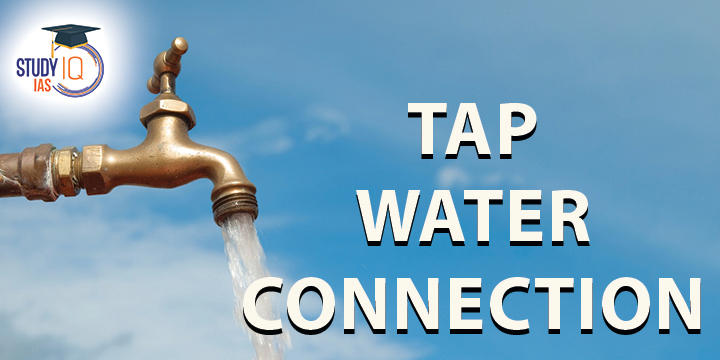Table of Contents
Water Connection: Objective
- Objective of Survey: To assess the functioning of the government’s Jal Jeevan Mission.
- Fully functional tap Water Connection is defined as a household getting at least 55 litres of per capita per day of potable water all through the year.
Water Connection: Highlight of Survey
- Under the ‘Har Ghar Jal’ villages, 91 per cent of the households were found to have a working tap Water Connection, which is higher than the overall national proportion (86 per cent).
- Functionality of household tap Water Connectionin the country increased by 14% in 2021-22 over the previous assessment in 2020-21.
- State Wise Coverage:
- More than 80% Coverage: Tamil Nadu, Himachal Pradesh, Goa, and Puducherry reported more than 80% of households with fully functional Water Connections.
- Less than 50% coverage: Rajasthan, Kerala, Manipur, Tripura, Maharashtra, Madhya Pradesh, Mizoram and Sikkim has less than 50% of households with fully functional Water Connection.
- States where functionality was less than the national average of 62% include Odisha (54%), Haryana and Jharkhand (55% each), Uttar Pradesh (57%) and Karnataka (58%).
- Aspirational District: 78 per cent of the households were found to have a working tap connection on the day of the survey, which is relatively lower than the overall national proportion (86 per cent).
- Institution Level: More than 90% of village-level institutions, such as schools and anganwadi centres, were getting potable water.
- Frequency of Supply: Close to three-fourths of households received water all seven days a week and 8% just once a week.
- On average, households got water for three hours every day, and 80% reported that their daily requirements of water were being met by the tap Water Connection.
- Quality: The water quality in some of the households was tested and revealed 95% of households to have within acceptable limits of pH values.
- Overall 93 per cent of the water samples were found to be free of bacteriological contamination.
- Purifying Method at household: More than half (57%) of the sampled households reported purifying water before drinking.
-
- Only around 3% of the households reported using reverse osmosis treatment for water purification prior to drinking.
-
- Concern of chlorine contamination: Most of the anganwadi centres and schools, had higher than the permissible range of residual chlorine and indicated inappropriate local dosing.
- There is a need to monitor the correct dosing of chlorine in the pipe water supply system,
- Chlorine within permissible limits is an indicator of a well-maintained and healthy piped water supply system.
Water Connection: Jal Jeevan Mission
- The Jal Jeevan Mission aims to provide safe and adequate drinking water through individual household tap connections by 2024 to all households in rural India.
- JJM looks to create a Jan Andolan for water, thereby, making it everyone’s priority.
- It comes under Jal Shakti Ministry.
- Financial outlay of ₹3.60 lakh crore, with the Central government funding 50% of the cost with States and Union Territories.
- Exception: North-eastern and Himalayan States and Union Territories with legislatures, where the Central government funds 90% of the bill and Union Territories without a legislature , where it funds 1000% of the bill.
- Performance till now: Goa, Telangana and Haryana have achieved 100% tap connectivity to all households.
- Union Territories like Puducherry, the Andaman and Nicobar Islands, Dadra and Nagar Haveli, and Daman and Diu, have also provided 100% of their households with tap water connections.
- Tap Water Connection doesn’t automatically imply access to regular potable water.


 India China Trade Deficit, India’s imp...
India China Trade Deficit, India’s imp...
 Current Affairs 29th April 2024 for UPSC...
Current Affairs 29th April 2024 for UPSC...
 Towards Green Growth, Impact of Climate ...
Towards Green Growth, Impact of Climate ...

















